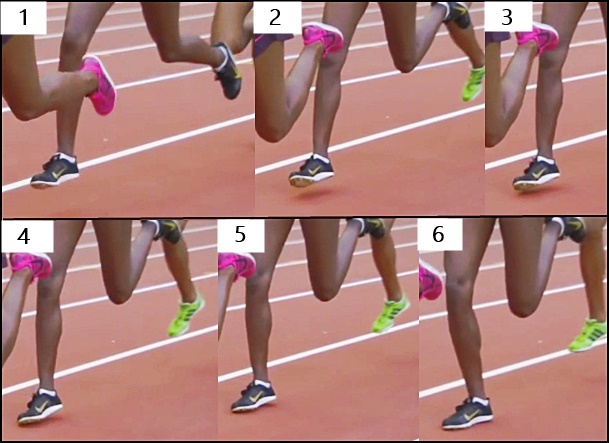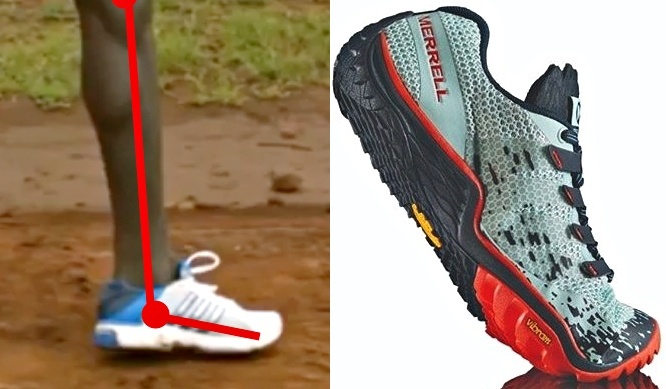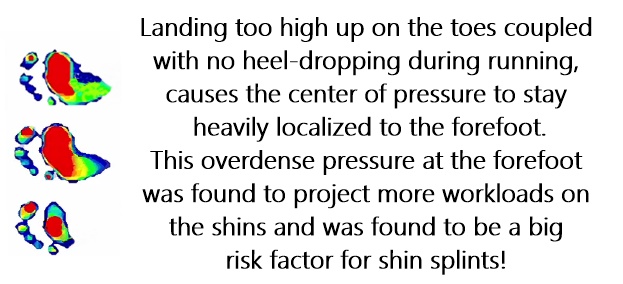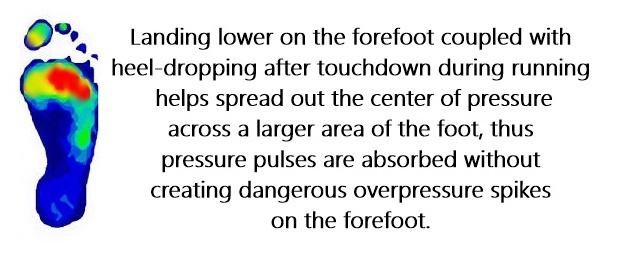A wealth of data over the past few decades has made it abundantly clear that forefoot running is significantly safer than heel strike running by all measures. Unfortunately however, forefoot running gets misconceived as toe strike running which is dangerous because toe strike running is enormously straining on the forefoot and lower leg.
Forefoot running and toe strike running are two different styles of running. Toe strike running involves landing high up on the toes without letting the heel drop down to the ground. Forefoot running is actually a much flatter foot placement at landing where initial ground-contact is made on the balls of the foot, not the toes, followed by the heel lowering down to the ground (shown below).
Toe running (shown above right), involves landing too high up on the toes coupled with not letting the heel drop to the ground. A huge problem with this is its significantly linked with over-straining the shins, causing shin splints, but that’s not the only problem. It also increases and localizes pressure impulse peaks to the forefoot. In other words, impact pressure cannot spread evenly over the foot like it should, and instead, causes overpressure on the forefoot where a metatarsal stress fracture is more likely to happen as compared with a forefoot strike landing (shown above left), which is a larger foot contact area because the strike angle relative to the ground is significantly lower.

The functional significance of forefoot striking when running is it dissipates pressure over a larger area of the foot, thus preventing pressure over-exposure on the foot, and prevents impact from spreading out on to the lower leg! In fact, it’s been said that “plantar (foot) pressure spreads best with this landing configuration” (shown below).


Bottom line, there’s really no point throughout the foot that gets hefty impact loads delivered to it in forefoot running. Also, the heel-lowering phase of forefoot running is very essential because the center of pressure appears to spread best as heel-lowering draws the center of pressure away from the forefoot AND was found to greatly minimize impact loads to the shins.
A proof of concept came from a study in the Journal of Orthopaedic & Sports Physical Therapy which found that a forefoot runner with shin splints had the center of pressure begin and end in the forefoot because the heel had not been dropping down after landing. This was found to increase mechanical demands on the connective tissues surrounding the tibia (shin) as a compensatory mechanism to try and disperse excessive pressure confined on the forefoot. Similar studies also found that runners with a history of shin splints had no heel-ground interaction!
In a forefoot strike landing, the center of pressure begins at the forefoot, under the 4th and 5th toes, and ends at the heel, after heel contact, helping to even out impact to the extent where pressure loads are prevented from spilling onto the shins. Most notably, knowing all of this presents a fresh take on how forefoot running prevents foot and shin injury!
Nevertheless, to avoid damaging impacts on the foot and leg, don’t be a toe-strike runner, be a forefoot runner because impact on the foot is proven to spread more efficiently and safely than both toe strike running and heel strike running.
Speaking of heel strike running, here are all the evidence-based reasons heel strike running is the most damaging, inefficient way to run.
If you’ve enjoyed my blog post on forefoot running, you’ll love my YouTube channel, RUN FOREFOOT, where you’ll learn more about why forefoot running is better than heel strike running and why running barefoot helps you run better in shoes!
References:
Cibulka et al. (1994). Shin splints and forefoot contact running: a case report. J Orthop Sports Phys Ther 20, 98-102.
Kentor, LA. (1948). Survey of the etiology of shin splints. Master’s thesis, Springfield College, Springfield, MA.
Lieberman et al. (2010). Foot strike patterns and collision forces in habitually barefoot versus shod runners. Nature 463, 531-5.
If you’d like, you can support Run Forefoot and help keep it going by making a donation in any amount of your choosing:

Or, you can also support Run Forefoot by shopping at the following top minimalist shoes brands, and be sure to bookmark the links:
Be Lenka: https://www.dpbolvw.net/click-7600968-14330828
FeelGrounds: https://www.feelgrounds.com/?p=RunForefoot
Xero Shoes: https://xeroshoes.com/go/Run_Forefoot
Iguaneye: https://www.iguaneye.com/?ref=8tfXVc92
Soft Star Shoes: https://shrsl.com/3mp1b
Wilding Shoes: https://bit.ly/3lIygQP
Earth Runners: https://earthrunners.com/?rfsn=6763579.f7f9c9
Vivobarefoot: https://shrsl.com/3kvih
Zappos: https://goo.gl/J1CeAd

Bretta Riches
BSc Neurobiology; MSc Biomechanics candidate, ultra minimalist runner & founder of RunForefoot. I was a heel striker, always injured. I was inspired by the great Tirunesh Dibaba to try forefoot running. Now, I'm injury free. This is why I launched Run Forefoot, to advocate the health & performance benefits of forefoot running and to raise awareness on the dangers of heel striking, because the world needs to know.
Latest posts by Bretta Riches (see all)
- Are Minimalist Shoes Good for Seniors? YES! - 14/04/2024
- BIG Deals On Running Gear And More! - 09/04/2024
- Why Are My Feet Tired After Running? - 04/04/2024



